| Visual Arts | The Netherlands | ||||||||||||||||||||||||||||||||||||||||||||||
BAFA © 2010. All material here is copyrighted. See conditions above. |
Jessy Rahman
|
Interview by Sonja van Kerkhoff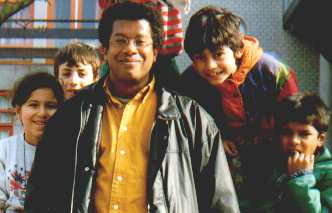
Jessy Rahman, The Hague, 1998, during his Laws of Children project. |
My 305 year old academy of visual arts in The Hague has a policy of inviting well known artists to give workshops, once every five years. In my third year at art school, Jannis Kounellis, a Greek-Italian and one of the leading arte povera artists, came to give a workshop for the sculpture and painting students. At the time there were lectures, workshops and performances. During this, ten of us decided to work on the beach while all the other activities took place within the art school buildings. It was our reaction, in the spirit of arte povera and land art. We wanted to involve the public. We decided to make a 3/4 circle form, ten metres in diameter and one and half metres deep. |
|
It was made spontaneously and in a sense was a direct response to the situation. It was winter and cold. So we made a shelter with materials found on the beach and with our bare hands. Once inside the form and seated, you felt protected from the biting winds that came direct from the sea, and at the same time, it created a nice micro-climate (a climate within a climate). It was so simple. The opening was physically necessary to create the micro-climate but also it was an opening or connection within the larger picture.
There were so many associations and things that happened, such as the daily supply of materials washed up by the sea during those seven days. For me, the piece really worked for the public as well, and it was my first experience in communicating with the public as part of a performance piece.
|

Sculpture by Jessy Rahman and other art students, 1988.
|
|
On one of the last days, Jannis Kounellis saw the work and seemed impressed. He was photographed with me. This photo has appeared in one of his catalogues as well in the book, Stralend fragmentarisch, as part of an essay by Rudi Fuchs (Director of the Stedelijk Museum, Amsterdam) which discusses how art today is more fragmented and crosses boundaries, etc.
In 1968 Jessy's parents immigrated to The Netherlands from Suriname, with Jessy, a seven-year-old, and his five siblings. It was also a year of many protests, the most dramatic being when students in Amsterdam in protesting against the educational system took over the University registry office. It worked, because a lot of changes appeared. In the same year there was a 'beeldenstorm' (an iconoclasm, a term from the 1600's when Protestants destroyed paintings and statues in Catholic churches). Students in many art schools destroyed the Greek and Roman plaster casts. Until that year all the academies based their subject matter on Greek and Roman models. Later Jessy saw some of the leftover broken casts of Greek and Roman culture lying in the cellar of his art school. The 1968 exhibition, "Op losse schroeven" (On loose screws) in the Stedelijk Museum was a landmark in Dutch contemporary art, because installations were a major part of the show, and because the nature of exhibiting art was questioned for the first time. For example, three Dutch artists had uncovered one of the foundation pillars of the museum as their art work, at the boundary between the museum and the street. Jannis Kounellis's installation consisted of an old fence laid against the walls in a corner, where sheep's wool had been hung... |
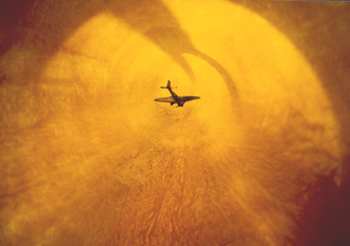
Hommage to Joseph Beuys, Object-Painting, a toy airplane inside a lit cone-form, 1989. | Joseph Beuys was influential in bringing materiality back into art. His thinking and work had a strong influence on Jessy's work. In 1989 Jessy made an object-painting as a homage to Joseph Beuys. It was an inverted cone coated in honey coloured resin which was lit from outside. Almost at the inner point of the cone, Jessy had wedged a small Stuka aeroplane so it seemed to float. This was the plane Beuys was in when he was shot down during World War Two. At that time he was rescued by the Tartars who wrapped him in fat, felt and fur to save his life. This was a turning point in Beuys' life, spiritually as well as literally. For Jessy this was Beuys on his real journey to the next world -his final destination in that aeroplane.... |
 Fishlight, 1990, mixed media. |
Fishlight, 1990, exhibited at his graduation exhibition, an internally lit polyester cone emerges from the ceiling. By installing it in the ceiling a tension was created in the vertical space between the open and closed cones. On the open cone form underneath, dried fish from Suriname were attached to the metal and faced upwards towards the light. Their upwards direction not only illustrated fish being attracted and then caught (as fish are when fishing at night) but symbolise migration (in this instance, Surinamese culture being attracted to and influenced by western (Dutch) culture). This theme of west verses non-west was further emphasised by use of the materials (industrial polyester in the cone above and smelly dried (natural) fish below) and lighting (the cone above illuminates the cone beneath). It was intended to be light-hearted and serious in its reference to the 'west-rest' world power relations and myopic views.
|
Flags
Then there were the elections and Czechoslovakia divided without a war. So my peace monument worked! Over the ocean and over the seas is a light-hearted piece about migration, and the never-ending movement of life and culture. The strips are a mix of natural and synthetic colours and function as a colourful backdrop. The Olivar Caribbeansis's and Buccinumundatum shells come from tropical and European seas, respectively. The name Buccinumundatum indicates that these are the buccaneers of the sea. This is a dig at the numerous Dutch pirate ships that frequented the Caribbean during the slave trade and at the height of Dutch naval power. Migrating from Suriname to the Netherlands means crossing the Caribbean Sea, the Atlantic Ocean, and the North Sea. So Jessy's own migration from Suriname was really over the ocean and over the seas. |
 Dutch Landscape, 1991, lead, paint, cow hide, board.
|
 Over the ocean and over the seas, 1992, lead, paint,
part of a wooden frame, glass, seashells. |
The Arts Collective - Quartair |
The exhibition they organised themselves in 1992, 'Two World Accents', involved artists from Germany and India. The collective has now made a contract to use this gallery space in the summer for their own projects, and in the winter months it is in the hands of the city arts council.
Quartair is now a platform for exchanges with arts groups in various countries. Often it involves an exhibition in their gallery which is then reciprocated. There have been exchanges with art groups in London, Berlin, Finland, Norway, Iceland, Arkansas, Suriname, Belgium, and India. The work often has a link to performance or installation. They also organise shows around a theme such as '750 metre Den Haag', (750 metres of The Hague) which was held the year the city celebrated its 750th anniversary. Installations by 20 artists addressed this theme in a variety of media. Another was '12x12', which was 12 hours of performances on June 12th 1999 by artists
from Europe. |
In 1997 Jessy, as a member of Quartair, was invited by the Indian artist Bhaskar Hande for a two month residency in Pune (200km north east of Bombay). Six of them travelled there, giving workshops, having an exhibition and working in the studios there.
During this time Jessy travelled to the mountains to work with the figurative sculptor, Kapuskar. He worked with Maharastran clay. Mixed with dung and straw, this clay is a major building material in the area. Jessy wanted to use traditional materials for his work. Another was rangoli, the sprinkling of pigment on the ground. This was traditionally done to inform visitors where to go for their meeting, etc. It was a means of communication. In the big cities, such as Pune, now it is only made as part of school competitions, to see who makes the most striking design. This has nothing to do with how it was originally used but the form of sprinkling pigment is traditional and requires great skill.
Mandalas are made like this.... |
 Detail: Rangoli, 1997,
ceramic, engraved sheet metal, pigment. |
Jessy chose fruit forms as the basis for this work for the exhibition, 'Holland/India, Give and Take in Art'. Working with students from the school of architecture, Jessy asked them to choose a fruit and to cut it in half and to draw these. From these drawings they all worked together on making rangoli fruit. A large leaf made of metal was placed on each of the 4 rangoli fruit. At one time in India, particular leaves were only used for people of a particular caste or status. For example a Brahman was only allowed to eat from a banana leaf. Small seed forms out of copper and ceramic were placed on and around these metal leaves to illustrate that food can be presented in various ways, just as there were and are various customs for eating. |
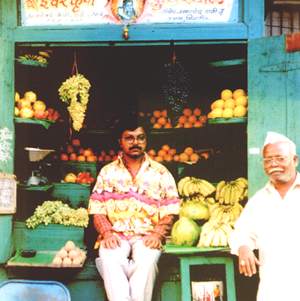 A performance project, in Pune, India in 1997.
|
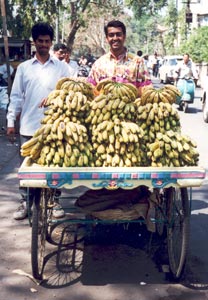 A performance project, in Pune, India in 1997. |
 A performance project, in Pune, India in 1997.
|
Jessy also did a performance project in the city, in which he used a shirt covered in images of tropical fruit bought in the Hague. He asked fruit sellers in the market to put this on and then took a photo of them in this.
It was a simple idea but an effective way of incorporating ordinary Pune city folk into his work. | ||||||||||||||||||||||||||||||||||||||||||||||||||||||||||||||||||||||||||||||||||||||||||||||||||
Another recurrent theme in Jessy's work is fauna, and in particular micro-organisms. As a child he had an aquarium and the micro-world there reminded him of the lively world of nature he experienced in Suriname. The details and the diverse micro-organisms are metaphors in Jessy's work for cultural activity and diversity.
| |||||||||||||||||||||||||||||||||||||||||||||||||||||||||||||||||||||||||||||||||||||||||||||||||||
In 1997 Jessy organised the exhibition, 'In Vivo', (the term refers to all the processes in a living cell or organism) in the Quartair gallery. Six artists made work that related to this theme. Most work was living in the form of either video or film or involving real living organisms. For example, Jessy's work 'Aquarium' consisted of six different micro-climates and ecosystems inside six aquariums. The differences were of temperature, oxygen supply, light and the differing water micro-organisms. |  Three of the Aquarium pieces in the exhibition, "In Vivo", 1997. |
Jessy placed a painting between each pair of aquariums. In the course of the six weeks the painted image, viewed through the water, was changed by the organisms growing and moving in front of them. |
 Variations of the Awasa dance,
Paramibo, Suriname, 1999. Photo by Jessy Rahman. |
Three months later in September Jessy went to Suriname for 2 months to work on his Mango Plantation piece. While he was there he also gave some workshops at the art school. He started his mango piece in 1998 with a performance in which he gave each person a mango and asked them to peel and eat it. They were then asked to place the pit in a plastic bag and then to label this with their name, place of birth and places of birth of their parents. Documentation there informed everyone that Jessy would plant the seeds in the plantation, "Wel Gedacht" near Paramaribo in Suriname, where he and his family came from. Jessy took about 50 pits to Suriname. It's a long story, but now the plants are growing strong. This is a long term project, which Jessy plans to expand with work about roots and in particular the Dutch connection with plantations. Once the plants bear fruit these will be sent to each of the pit-suppliers where possible. After the tragic history of plantation life and slavery Jessy wants to enkindle the connections between the Netherlands and Suriname in a positive way. The plantations are also historical sites, and trade goes both ways.
| ||||||||||||||||||||||||||||||||||||||||||||||||||||||||||||||||||||||||||||||||||||||||||||||||||
These shells were the instruments of the Awasa dance: you dance fast, you dance to play the instrument. He took these seeds back to Paramaribo where he found some Maron people in the suburbs who made them into the ankle instruments. Jessy filmed an old woman making them and then filmed her daughters and grandchildren performing variations of the Awasa dance.
It seemed more than just coincidence to Jessy to discover a fruit, that was a musical instrument performed by dance.
|
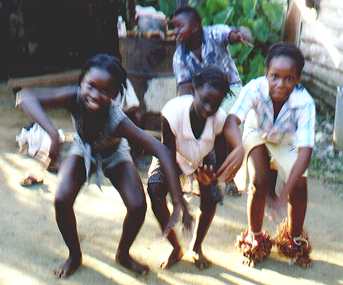
Children dancing variations of the Awasa dance,
Paramibo, Suriname, 1999. Photo by Jessy Rahman. |
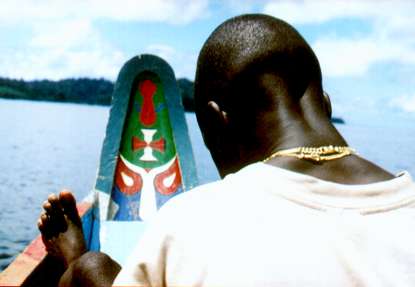 Photograph by Jessy Rahman in Suriname, 1999.
|
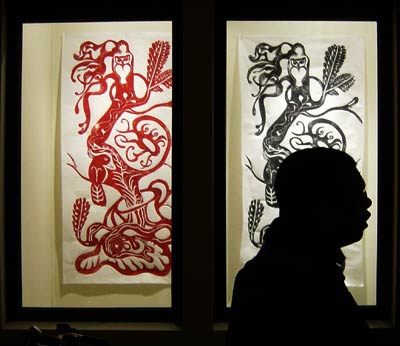 Woodcuts by Jessy Rahman, 2002, with a profile of the artist himself. Photo: P.D.D.
|
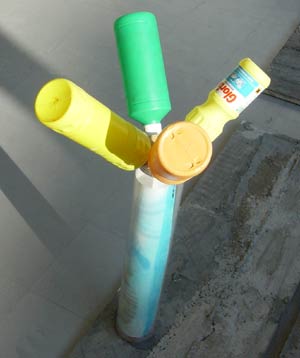 "Buoy", a performance/project by Jessy Rahman + Wim van Egmond, 2003.
| Text to come, explaining what happened. | 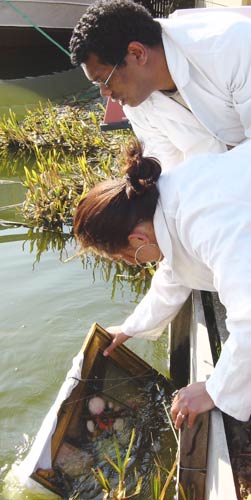 "Buoy", a performance/project by Jessy Rahman + Wim van Egmond, 2003.
|
|
Sweet Jessy, gingerbeer vendor performance, at the 2004 Nine Dragonheads Environment Arts Festival, South Korea. 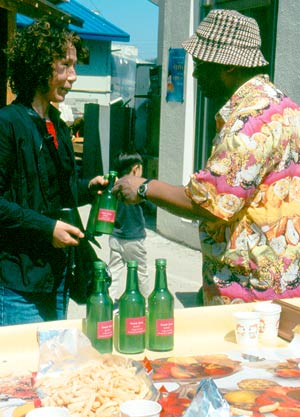 Chae Myung-Soo + Jessy Rahman, 2004. |  Detail showing a Sweet Jessy label. |
|
Arts Dialogue, Dintel 20, NL 7333 MC, Apeldoorn, The Netherlands email: bafa@bahai-library.com |